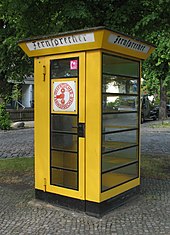Berlin-Lübars
|
Lübars district of Berlin |
|
|---|---|
| Coordinates | 52 ° 37 ′ 0 ″ N , 13 ° 22 ′ 0 ″ E |
| surface | 5.0 km² |
| Residents | 5203 (Dec. 31, 2019) |
| Population density | 1041 inhabitants / km² |
| Incorporation | Oct. 1, 1920 |
| Post Code | 13469 |
| District number | 1208 |
| Administrative district | Reinickendorf |
Lübars is a part of the Berlin district of Reinickendorf and the oldest village in Berlin where agriculture is still practiced today. In it you can find a lot of nature and a preserved village structure with a baroque village church from the end of the 18th century. Lübars is located on the Tegeler Fließ , which is an Ice Age drainage channel and flows into the Tegeler See . Lübars is characterized by a diverse fauna.
history

Lübars was founded as Angerdorf around 1230 during the German settlement in the east . From ancient times it belonged to the Benedictine convent Spandau , which was founded in 1239. The first written mention of Lübars (as Lubars = place that belongs to a man named Lubas) comes from the year 1247. The village floodplain was the focus of village life. That is why there was a village pond right next to the village church . After the Middle Ages, a fire station and a school house were added.
In the land book of Charles IV (1375) Lubas / Lubaz / Lubasz is mentioned with 28 hooves , four of which are parish hooves. In the village there are six kossaten , a Schulzen and a jug (taberna) . This information is proof of the significant impact the Black Death (1346–1353) had on population development, because 46 hooves are mentioned as early as 1270, 1450 and 1480: 44 hooves and 1527: 48 hooves.
An old thatched shepherd's house in Lübars from the middle of the 19th century tells of the residents of earlier centuries. At the time when the city of Berlin was expanding into the surrounding area, more people also settled in the villages, they erected low residential buildings, some of which were decorated with stucco . The historic Alter Dorfkrug Lübars inn, which is under monument protection , together with the ballroom, which has been restored according to the historical model, has been preserved and is still used to host guests today.
In 1920 Lübars was incorporated into Greater Berlin .
Lübars is known for the Lübars amusement park on the edge of the village , which was laid out over the course of several years on an old garbage dump that existed here until 1975 and was completed in 1993. In addition to a youth farm, which primarily invites city children to get to know large animal husbandry, there are also a number of hiking and cycling trails, bridle paths, grass skis, lawns and viewpoints. A special attraction of the amusement park is the 300 meter long ski and toboggan slope with floodlights.
In West Berlin , Lübars was a curiosity and a sight until the fall of the Berlin Wall in 1989 , as it was the only settlement with a largely village character within the then walled and densely populated metropolis. School classes, city dwellers and tourists were able to watch the few Berlin farmers cultivating their fields in Lübars.
Lübars gained notoriety for the insidious murder committed there of the 21-year-old horse hostess Christin Rexin on June 21, 2012.
See also
- List of streets in Berlin-Lübars
- List of cultural monuments in Berlin-Lübars
- List of stumbling blocks in Berlin-Lübars
literature
- Wolfgang Ribbe, Jürgen Schmädeke: Small Berlin story. 3rd expanded edition. Stapp Verlag, Berlin 1994, ISBN 3-877762-22-0 .
Web links
- The Lübars district, Reinickendorf district office of Berlin, 2002
- LabSaal Lübars - Our surroundings in picture (and sound) . Some Lübarser photographs, Labsaal.de, Ed. Gerhard Dallmann, Natur & Kultur e. V., Lübars, 1997
Individual evidence
- ↑ The district of Lübars. February 27, 2014, accessed June 14, 2018 .
- ^ Amusement park Lübars / State of Berlin. Retrieved June 14, 2018 .



